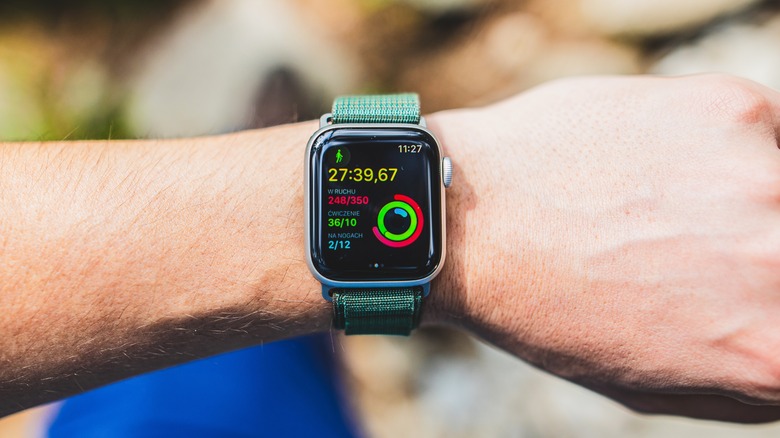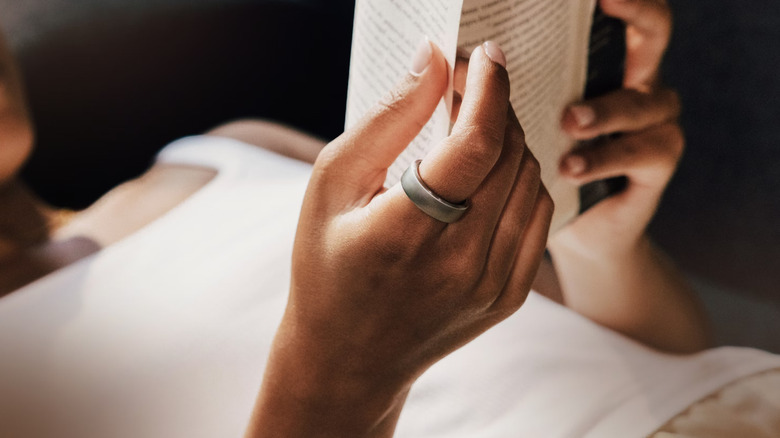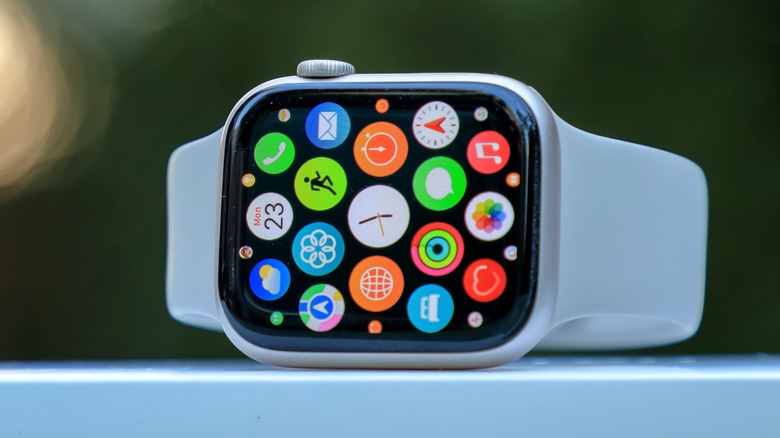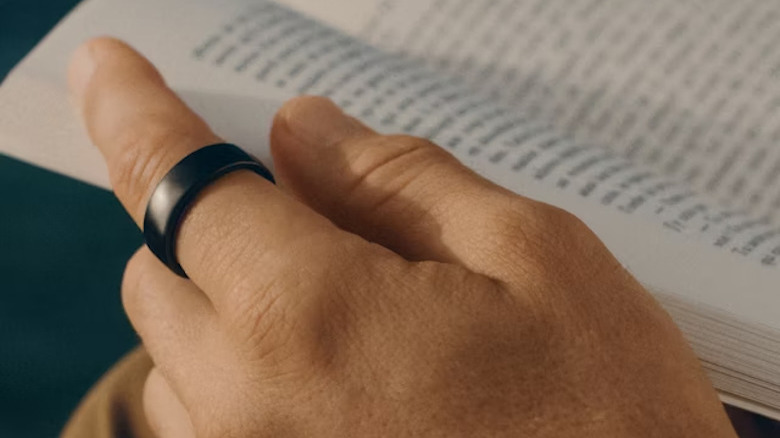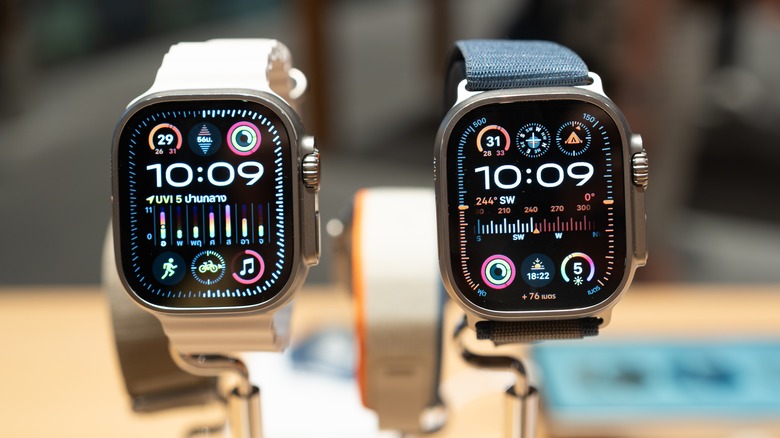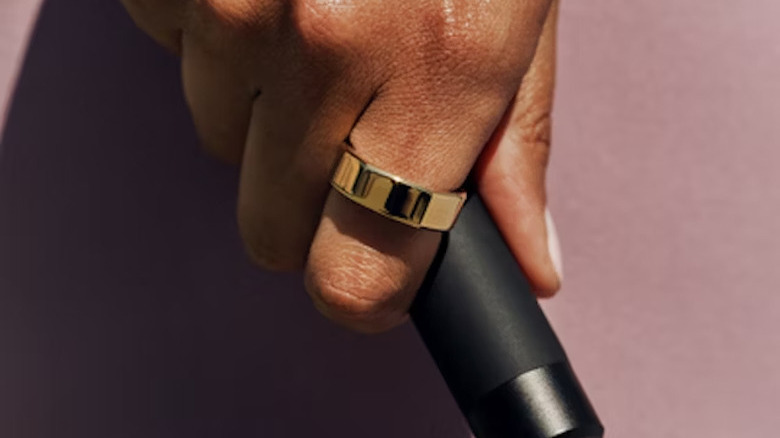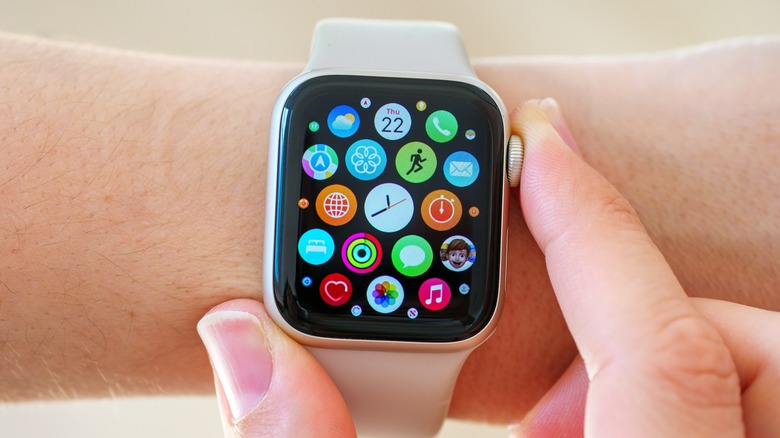Oura Ring Vs. Apple Watch: How Do These Wearable Health Trackers Compare?
There are many devices for people to track their health. Whether you're going on serious diets and exercise regimens or simply like to know your day-to-day activity levels, these health trackers can be of a great benefit for those looking to live a healthier life.
One of the most popular devices on the market to monitor health is the Apple Watch. Because this is a device that is able to do so much beyond simply tracking your health — such as sending and receiving text messages and using Apple Pay for contactless payment — it being able to do all of the things you want from a health tracker is almost an added bonus. In the last few years, though, another company has emerged to bring something new to the health tracking space, and it did it with the Oura Ring.
Rather than having a device strapped to your wrist, the Oura Ring is exactly that, a ring you put around your finger. How you wear these devices isn't the only difference between them, and weeding through the details of what device does what can be a little daunting. So, if you are looking to get yourself a new health tracker, perhaps this little guide will be able to help you determine whether the Apple Watch or the Oura Ring is the right option for you.
They have very different price ranges
One of the most important factors for someone to purchase anything, let alone a health tracker, is price. Neither the Apple Watch or Oura Ring are particularly inexpensive, but the range that the various models of each is quite wide. Currently, the Apple Watch is available in four different models. The least expensive is the Apple Watch SE, which has a starting price of $249. From there, the prices go up to $399 for the Series 9 model, $799 for the Ultra 2, and the Hermès starts at $1249. As the prices increase over the models, this is accounting for things like stronger material, premium wristbands, and processing chips.
There are two different models of the Ring, the Heritage and the Horizon — the difference between them being the sleekness of the ring's shape — and the cheapest you are able to get one is a Heritage for $299. Meanwhile, the starting price for the Horizon is $349. That is not where the costs end, because each model comes in a variety of different finishes that can dramatically increase the price. The most expensive Heritage model comes in Gold and costs $449, while the Horizon has a $549 Rose Gold model too. There is one cost with the Oura Ring that you don't have with the Apple Watch, and that is a $5.99 monthly charge to have access to all of the health features available. The Apple Watch has them as a base level.
Physical differences beyond just being a watch and a ring
The most visible difference between the Apple Watch and the Oura Ring is that you wear the former on your wrist and the latter on your finger. The physical designs of the two, however, divert a great deal more than just that.
The Apple Watch has an interface built-in to the actual watch face. This is not just a place where you are able to check the time, it can also act as a hub for all of your health tracing needs. If you want to check your daily step count, go over data from your workout, check on your heart rate, and more, you are able to do it directly from your watch. This is extremely beneficial for checking on immediate readings or short-term progress.
Because the Oura Ring looks like any other ring you might wear on your finger, it features no interface on the device itself. Any data you may want to see that the Oura Ring has tracked will have to be done by pulling out your smartphone. You can't simply look down to check on the distance of your morning jog or even make sure that the Ring is tracking anything you are doing. For long-term tracking and examining patterns, the Oura Ring works perfectly, but you may find it somewhat lacking when you need to pull out your phone to see proof. However, that annoyance may be offset by the ease of wearing a ring. Not everyone feels comfortable wearing a watch, finding it heavy and cumbersome, particularly it fitness settings. A simple ring can be a lot less noticeable.
A tale of vastly different battery lives
We also need to look at the most basic functional element of these health trackers, and that is their batteries. These devices are meant to be worn most of — if not all of — the time, and having one that can keep its charge is important if you want to get the most information about your health. It is here where the Oura Ring is able to greatly outshine the Apple Watch.
According to the company, the Oura Ring can last up to seven days on a full charge if you wear it 24 hours a day. Various reviews from Consumer Reports and Tom's Guide, dispute this a little. The former was able to keep a full charge for six days, but the latter found that a single charge would last closer to three days if every feature, like the blood oxygen monitoring, was enabled at all times. Regardless of its battery life, its charging time is very fast, returning to a full charge in around 30 minutes.
Because the Apple Watch has a more robust interface and is able to perform so many functions outside of being a health tracker, its battery life isn't nearly as long. Apple has the lower tier models maxing out at 18 hours with upper tiers hitting 36 hours, and it can take anywhere from 75 to 150 minutes to get it back to 100%, depending on the model.
The Apple Watch and Oura Ring share many similar features
For the most part, the Apple Watch and Oura Ring keep track of many of the same things. Both devices monitor heart health by measuring your heart rate, whether you are resting or engaged in some kind of workout. Each one is also able to track the active calories you burn in a day from your physical activity, which includes normal calorie burning in day-to-day life.
The Apple Watch and Oura Ring also want to keep you moving throughout the day, so they will each track the number of steps you take during the day, along with the accompanying distance. Plus, if you have not moved or been standing, they will send you a little notification to remind you to get up and move around a bit. Both devices also allow you to set daily goals for how much activity you wish to partake in. These goals don't just include timed goals but also calorie burning goals as well.
Their tracking can get much more specific beyond general physical activity. Both are able to monitor your sleep patterns, and if you are a person who needs to, you can keep track of your menstrual cycle, which also comes with estimations on when your next period will be. The two devices also come with mental health tracking, allowing you to keep track of how mindful you are being everyday.
The benefits of the Oura Ring
Despite the fact that the Oura Ring and the Apple Watch share so many of the same features, there are plenty of ways that the Oura Ring stands. The first goes back to a previously mentioned factor: the battery life. Because the Oura Ring battery life is so long, you can maximize the tracking that the Ring is able to do. This is particularly beneficial for the sleep tracking features. The Apple Watch can take a couple of hours to fully charge, and the only time you may find it convenient to charge the device is while you're sleeping, effectively eliminating the use of those trackers. Plus, the Oura Ring is less cumbersome, which means the chances of it disturbing your slumber is greatly reduced.
One of the biggest drawbacks of the Apple Watch is that it can only be paired with other Apple devices. Because Oura is its own independent company, it has no exclusivity and can be paired with Apple and Android devices alike. Getting an Apple Watch without having an iPhone in your pocket would basically make it functionally inoperable. The Oura Ring expands the customer base for those who want a health tracker.
The Oura Ring also has some features that are exclusive to it. Most notably is the ability to measure your blood oxygen level. The Apple Watch used to have this feature, but a lawsuit required the company to get rid of it. It only does this during sleep tracking, but being able to detect breathing problems during sleep can help combat sleep apnea.
The benefits of the Apple Watch
As a health tracker, the Oura Ring basically has everything that the Apple Watch does, and in some cases, it has a bit more to offer. However, there are plenty of ways that the Apple Watch outshines the Ring. This is particularly evident when it comes to tracking your workouts. The Apple Watch can automatically detect that you are performing a variety of different workouts. Yes, the Oura Ring can pick up if you are out for a run, but for non-cardio activities, you will have to get out your phone and indicate on the app that you are going a certain exercise. Meanwhile, the Apple Watch will automatically pick up just about everything you do, and if it doesn't you can quickly log it on the Watch itself.
While the Apple Watch doesn't lock features beyond a monthly paywall like the Oura Ring does, there is a different, optional monthly service you can pay for to help maximize your health tracking with the Watch. That is with Apple Fitness+, which is a service that provides you a ton of guided workouts that are able to cater to a variety of different fitness levels. These workouts range from yoga to weight training to cardio. All the Oura Ring can do is track your workout, not guide it.
Then there are all of the benefits outside of the Apple Watch being a health tracker. Whether that be answering phone calls, checking the weather, or letting you know you are in too loud of an environment, the overall functionality greatly outpaces the Oura Ring.
Which health tracker should you choose?
The Apple Watch and the Oura Ring perform many of the same tasks and are both able to keep track of your day-to-day health. Of course, it should be noted that the readings and patterns you find on these devices are not a substitute for a medical professional. Even though both devices come recommended, they are not doctors, nor are they foolproof. That said, there are plenty of cases of these two devices helping people take control of their own health in positive ways.
Despite their similarities, the two devices are there to serve two different marketplaces. If all you want is a health tracker, then the Oura Ring is the way to go. It's out of the way and provides you with loads of data on how your body works over a long period of time. Meanwhile, the Apple Watch is for people who want both a health tracker and all of the benefits one is able to get out of a high-functioning smart watch. The Apple Watch will be more fully integrated into your everyday life, but its top priority isn't being a health tracker. That's just one of the many things it does. You aren't going to go wrong with either product. It ultimately comes down to personal taste.
Also, it comes down to whether or not you already have an iPhone. That plays a big factor too.
